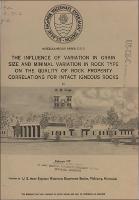Please use this identifier to cite or link to this item:
https://hdl.handle.net/11681/11381| Title: | The influence of variation in grain size and minimal variation in rock type on the quality of rock property correlations for intact igneous rocks |
| Authors: | Crisp, Robert W. |
| Keywords: | Granite Igneous rocks Rock properties Rock tests Tonalite |
| Publisher: | Concrete Laboratory (U.S.) Engineer Research and Development Center (U.S.) |
| Series/Report no.: | Miscellaneous paper (U.S. Army Engineer Waterways Experiment Station) ; C-71-2. |
| Description: | Miscellaneous paper Abstract: Previous rock property correlations have generally encompassed many rock types, the objective being to determine general relationships typical of all rock types The data, however, have frequently exhibited such a great degree of scatter that subsequent correlations were of questionable value. Thus, in an effort to eliminate some of the scatter typical of many previous rock property correlations, this investigation was conducted to determine the influence of' variation in grain size and minimal variation in rock type on the quality of rock property correlations for intact igneous rock types Physical property tests were conducted on 79 cylindrical specimens of granite and tonalite representing 10 drill sites. Values of ultimate uniaxial compressive strength and static Young's modulus of elasticity (tangent) were correlated with values of ultrasonic compressional pulse velocity, ultrasonic shear Pulse velocity, ultrasonic Young's modulus, ultrasonic shear modulus, ultrasonic bulk modulus, and ultrasonic Poisson's ratio for each of the four following groups of specimens: (a) all tonalite specimens tested from the Sierra Nevada Batholith, Calif., (b) all tonalite specimens tested, (c) all granite specimens tested, and (d) all specimens tested. Comparison of the nature and quality of these linear correlations revealed that variation in grain size, as opposed to variation in mineral composition and geologic history as allowed within the confines of a particular rock type, appears to have primary influence on the degree of scatter typical of rock property correlations for a particular intact igneous rock type. Moreover, rock property correlations involving only one igneous rock type are generally superior to those involving several igneous rock types, the latter case frequently suffering from an overall lack of quality due to a larger degree of scatter brought about by the amalgamation of data relationships exhibiting different trends and different degrees of linear association. |
| Rights: | Approved for public release; distribution is unlimited. |
| URI: | http://hdl.handle.net/11681/11381 |
| Appears in Collections: | Miscellaneous Paper |
Files in This Item:
| File | Description | Size | Format | |
|---|---|---|---|---|
| MP-C-71-2.pdf | 10.44 MB | Adobe PDF |  View/Open |